Natural disasters exacerbated by global warming kill some 60,000 people every year. As climate change impacts accelerate, the world is turning to two key strategies: mitigation and adaptation. Together, they form the foundation of the global response to the climate emergency, and are our best hope to protect ourselves and our planet from its devastating and irreversible impacts.
—
Since the 19th century Industrial Revolution, global emissions of greenhouse gases such as carbon dioxide have skyrocketed, primarily due to human activities like the burning of fossil fuels, deforestation and agriculture, and so have global temperatures.
Specifically, global carbon dioxide emissions have increased 182-fold, from 204 million tonnes in 1850 to 37,100 million tonnes in 2022. Meanwhile, the planet is now 1.3C warmer than it was in the pre-industrial era.
Although the temperature difference appears minimal, it is linked to dangerous temperature extremes and severe disruptions to natural climatic cycles, which have led to a greater occurrence of wildfires in places such as Australia and the US, the melting of ice sheets and rising sea levels, scorching heatwaves, increased flooding and countless other natural disasters.
Addressing the climate crisis requires a dual-pronged approach focusing on both climate mitigation and climate adaptation.
Mitigation
Climate change mitigation refers to a course of action aiming to reduce the severity of climate change impacts, primarily by preventing or reducing greenhouse gas emissions. In turn, this can lessen the severity and frequency of future extreme weather events, including heatwaves, floods, storms and tropical cyclones, droughts and compound events of multiple extremes.
Emissions reduction can be achieved first and foremost by transitioning away from fossil fuels to cleaner forms of renewable energy. Solar PV and wind in particular account for 95% of all renewable capacity growth through the end of this decade due their growing economic attractiveness in almost all countries.
Carbon sinks such as forests and oceans are our biggest natural allies in reducing emissions – making projects to increase forest coverage and protect natural environments like wetlands and grasslands necessary mitigation strategies. Shifting to sustainable agricultural practices can also help significantly reduce emissions, given that the agricultural sector contributes roughly a quarter to a third of global greenhouse gas emissions.
Adaptation
According to the Intergovernmental Panel for Climate Change (IPCC), climate adaptation refers to efforts aimed at reducing climate risks by primarily adjusting existing systems to reduce vulnerability and increase our capacity to cope with a changing climate. Improving infrastructure, developing new technologies, and implementing disaster risk reduction measures are all valid examples of climate adaptation strategies.
Increasingly frequent and severe extreme weather events such as fires or floods can disrupt urban infrastructure by damaging roads and destroying homes, requiring local governments to build more climate-resilient infrastructure and buildings.
Sea level rise is another threat that climate adaptation has sought to address. Small island developing states (SIDS) are particularly vulnerable to rising sea levels due to their low elevation, small land area and relatively large coastlines. Even very modest increases in sea level can cause chronic coastal flooding in these areas. When combined with relatively large coastlines and small land areas, SIDS have limited ability to relocate people.

Tuvalu Foreign Minister’s historic speech at the 2021 United Nations COP26 became a symbol of Tuvalu and other small island nations’ sinking fate. Photo: Ministry of Justice, Communication and Foreign Affairs, Tuvalu Government (Screenshot).
Climate adaptation strategies seeking to reduce these impacts include nature-based solutions such restoring beaches with sand and vegetation or growing mangroves and oyster reefs. But there are other valid approaches, with adaptation strategies also including funding the relocation of communities to more inland or elevated areas that are less prone to sea level rise, as well as constructing new housing for those communities to live in.
Considering the limited adaptation options for Pacific Island nations like Tuvalu, which risks disappearing completely by the end of the century, new migration pathways are also being explored. For example, Australia recently issued the world’s first climate visa for Tuvalu citizens affected by sea level rise, offering them a pathway to permanent residency.
National Approaches
While climate mitigation aims to reduce long-term climate risks, climate adaptation seeks to reduce current risks arising from historical emissions or a failure to reach mitigation targets – and it is considerably more underfunded than mitigation. In 2021 and 2022, approximately 91% of funding to combat climate change was directed towards climate mitigation efforts.
Climate change mitigation centers around one central objective: emissions reduction. This is something that can be achieved at large scales by reorientating major industries such as construction or energy.
Even with no policy direction, the very awareness of carbon emissions being an issue has led to many industries updating their technologies to be less carbon intensive. When governments and policies align on a global level, it creates massive uniform impetus for change.
Contrastingly, climate adaptation can mean different things in different regions, economies and cultures, and it is arguably not as easily applicable and scalable on a global level. Instead, it often requires a tailored approach that considers the diverse perspectives of stakeholders within a region, rendering it difficult to develop universal criteria.
According to the most recent report by the Intergovernmental Panel on Climate Change (IPCC), least developed countries and SIDS are shown to be less resilient to climate shocks, leading to irreversible losses in ecosystems. These regions also face challenges due to their limited financial resources, making it difficult to adapt effectively to a rapidly changing climate.
In contrast, industrialized countries typically possess the resources and infrastructure to manage climate disasters internally, although this capability does not always translate into effective action.
The Global Environment Facility (GEF), a financial assistance mechanism for developing countries to implement international environmental treaties, has faced criticism for its perceived bias towards issues prioritized by the Global North, such as greenhouse gas emissions mitigation, rather than focusing on the needs of lesser developed countries, like enhancing climate adaptation capabilities. This bias is evident in the significant disparity in funding between climate mitigation and adaptation efforts.
While historical contributions to greenhouse gas emissions have pressured developed nations to prioritize mitigation, it remains essential for them to realize their responsibility in adequately funding climate adaptation initiatives as well.
All or Nothing
Climate mitigation and adaptation are interdependent – with greater focus on mitigating climate change ultimately reducing the need for adaptation measures.
Strategies to improve climate mitigation, like growing more forests to reduce carbon emissions, also buffer ecosystems and can reduce the damage of natural disasters, thereby improving our ability to adapt.
Greater climate adaptation also makes economies more robust, freeing up more resources and funding for future mitigation efforts. For example, the construction of an effective flood barrier through engineered solutions such as inflatable dams or natural solutions such as wetlands can reduce the economic damage arising from floods, funds that the government can instead allocate for climate mitigation technologies such as solar farms.
Conclusion
Through ignorance and inaction, the world has failed to prevent climate change exacerbation. Global emissions and environmental degradation continue indiscriminately. However, the future is not set in stone, and the world can still shift course by undertaking mitigation initiatives to prevent further exacerbation as well as climate adaptation to ensure that the vulnerable survive this human-made crisis.
Featured image: Lula Oficial/Flickr.
Our non-profit newsroom provides climate coverage free of charge and advertising. Your one-off or monthly donations play a crucial role in supporting our operations, expanding our reach, and maintaining our editorial independence.
About EO | Mission Statement | Impact & Reach | Write for us
